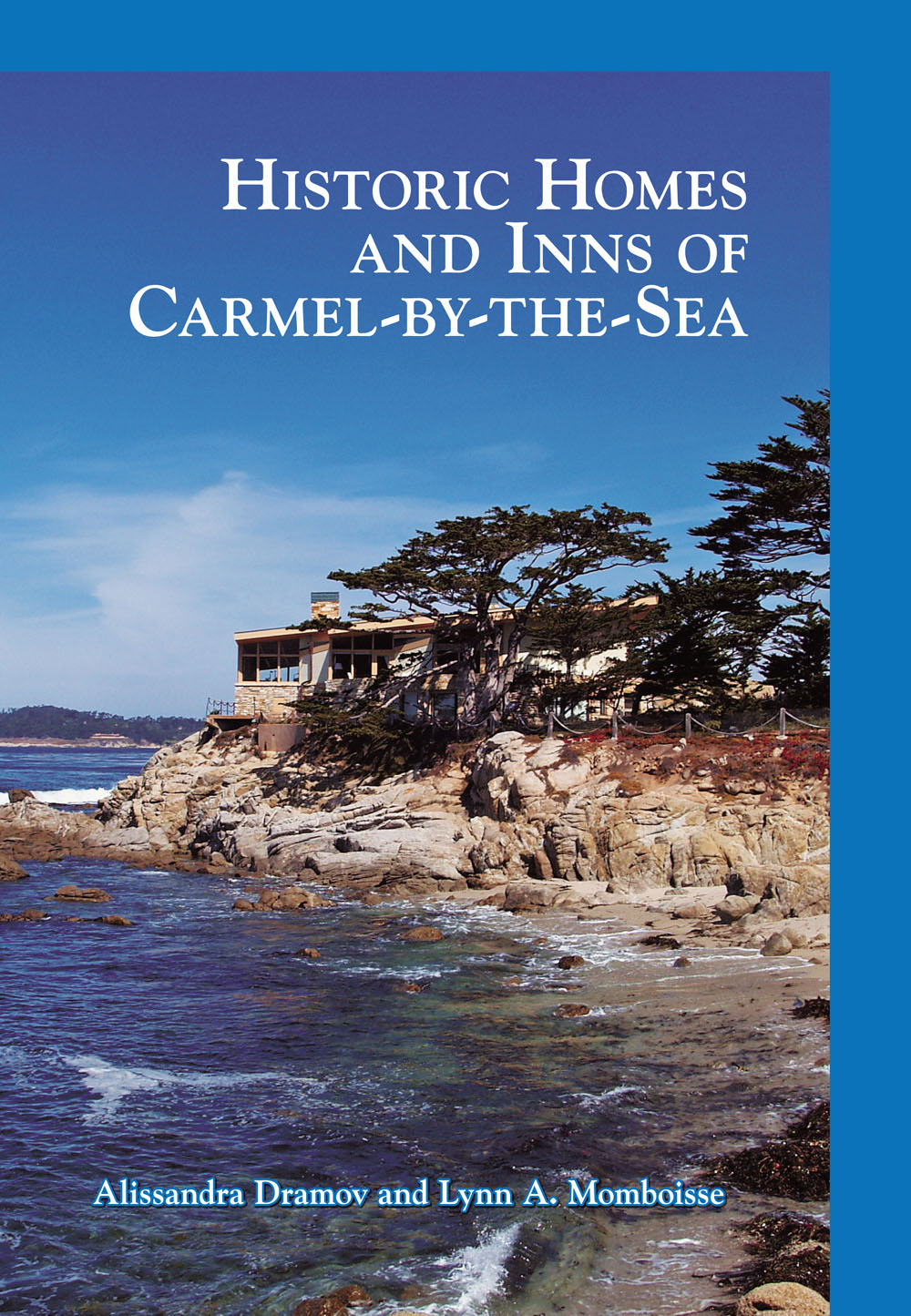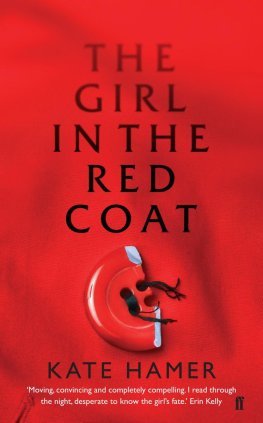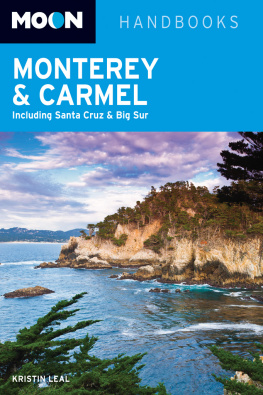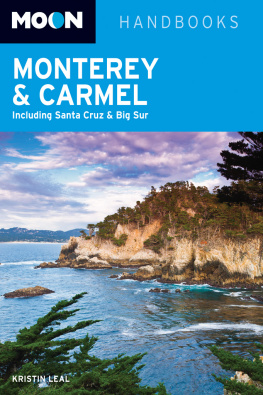
HISTORIC HOMES
AND INNS OF
CARMEL-BY-THE-SEA

CARMEL MISSION. Franciscan father Junpero Serra founded Mission San Carlos Borromo in 1771 near the Carmel River. He used it as his headquarters and was buried there in 1784. Two real estate agents, brothers Santiago and Belisario Duckworth, established Carmel City as a Catholic summer resort, which existed from 1888 to 1902. It became Carmel-by-the-Sea in 1903 under developers Frank Devendorf and Frank Powers. (Authors collection.)
FRONT COVER: Henry Johnson House, located on Carmel Point, is one of only five houses built directly on Carmels seacoast. It has sweeping views of Carmel Bay and Pebble Beach to the north, with Pescadero Point in the distance. (Authors collection, see )
BACK COVER (from left to right): La Playa, the hotel known as the Grande Dame of Carmel (Authors collection, see pages )
HISTORIC HOMES
AND INNS OF
CARMEL-BY-THE-SEA
ALISSANDRA DRAMOV AND LYNN A. MOMBOISSE

Copyright 2016 by Alissandra Dramov and Lynn A. Momboisse
ISBN 978-1-4671-1597-1
Ebook ISBN 9781439656747
Published by Arcadia Publishing
Charleston, South Carolina
Library of Congress Control Number: 2015915212
For all general information, please contact Arcadia Publishing:
Telephone 843-853-2070
Fax 843-853-0044
E-mail
For customer service and orders:
Toll-Free 1-888-313-2665
Visit us on the Internet at www.arcadiapublishing.com
CONTENTS
ACKNOWLEDGMENTS
Special thanks go to R.M.M. and B.D. for their continued advice and support.
Research material was obtained through public records. We would like to thank the Community Planning and Building Department staff at Carmel City Hall for their assistance. Librarians Ashlee Wright at the Henry Meade Williams Local History Department of the Harrison Memorial Library in Carmel-by-the-Sea and Dennis Copeland at the Monterey Public Library California History Room were helpful. We also thank local architectural historians Kent Seavey and Richard Janick for their many years of research, which laid the foundation for this book. All photographs were taken on public property and are courtesy of the authors.
To be designated as historic, a property must be at least 50 years old, with a significant builder and/or notable resident. Whenever possible, original names of owners who commissioned the building design were used. There are no street numbers in Carmel-by-the-Sea; therefore, addresses are given by compass coordinates. The number in front of the direction indicates how many lots away the property is from the intersection. An interactive map of the homes and inns in this book can be found online at www.goo.gl/4FVmOz.
INTRODUCTION
Carmel-by-the-Seas historic homes and inns have mirrored architectural trends in the country but with unique qualities based on the individuality of the towns residents and builders. When Carmel City was founded in the late 19th century, the houses were typically vernacular cottages, mostly constructed by carpenters such as Delos Goldsmith, the towns first builder. Some had Victorian era style influences. In Carmel-by-the-Seas first two decades, from early 1900 to 1920, it was a haven for Bohemian artists and writers, along with professors, mostly from the San Francisco Bay Area. They were content with simple Craftsman-style bungalows or beach cottages, often board-and-batten structures, some of which they constructed themselves.
Shortly after it was founded, a young man from Mendon, Utah, whose experience was as a house painter, moved to Carmel-by-the-Sea in 1904 and soon became the towns official builder. Thus, Michael (M.J.) Murphy Jr. (18851959) began four decades as Carmels most prolific contractor, until his retirement in 1941. By the 1930s, it was estimated that he built four out of five houses in town. No one else constructed more homes and buildings in Carmels history, a total of 350. When he started his career, Murphy frequently constructed Craftsman-style cottages using local, natural building materials. As the country entered the Roaring Twenties and its economic boom, Murphys designs evolved with the times and with his clients wants. He built larger and more sophisticated residences, often in the European Revival styles (English, French, and Spanish) popular in that period. No matter the style, M.J. Murphy was always known for his quality craftsmanship.
Carmel attracted new residents along with wealthy summer visitors who constructed second or vacation houses during this era. These homes were often done on a grander scale not seen before in the town. In fact, some of Carmel-by-the-Seas inns had once been large residences, while others were groups of guest cottages. Many homeowners, as well as designers and builders, had been to Europewhether by heritage or through travel, education, or service in World War Iand were familiar with European architecture. Notable architects were commissioned primarily from the San Francisco Bay Area to build these individual custom homes and inns. They included Albert Farr, Henry Gutterson, and George McCrea, along with the firms Blaine and Olson and Swartz & Ryland. After he was hired to design a massive stone residence on the Carmel Highlands coastline, Southern California architect Charles Greene relocated to Carmel-by-the-Sea.
In the mid-1920s, a rancher from Santa Rosa who first came to Carmel to visit his artist sister and her husband forever left an imprint that defined the quaint architectural character of the village. Hugh W. Comstock (18931950) was born in Evanston, Illinois, and moved to California with his family in 1907. During that trip to Carmel in 1924, he met and shortly thereafter married local doll designer Mayotta Browne. At a cost of $100, combined with admiration for British childrens book illustrator Arthur Rackham, but no construction trainingjust his imaginationComstock built a 244-square-foot studio (Hansel) as a showcase for his wifes doll collection. The whimsical little cottage in the woods triggered the fairy tale building trend that established the familiar, charming appearance of the village. Carmel-by-the-Seas architecture thereafter became identified with the Tudor Storybook style.
Other main local builders of the 1920s and 1930s in Carmel were Lee Gottfried, Ernest Bixler, Percy Parkes, Frederick Bigland, Guy Koepp, George Whitcomb, and Miles Bain. From that time onwards, creative and independent women such as Ann Nash and Dorothy Bassett, Dene Denny and Hazel Watrous, and Laura Maxwelloften without any building experiencealso crafted houses. The Great Depression years of the 1930s led to the construction of more modest and simpler houses, with less adorned architecture. Noted Bay Area architect Julia Morgan designed a house in the Minimal Traditional style, which overlooked the Carmel Mission. Local architect Robert Stanton was one among several who devised a house with prefabricated building materials to cut costs.
In 1941, an artist-by-training designed Carmels first Modernist subdivision, Sand and Sea. Jon Konigshofer (19061990) was born in Alameda, California, and studied art and design at the Art Students League in New York City and the California College of Arts and Crafts in the East Bay. He arrived in Carmel-by-the-Sea in 1937 and spent a year as a draftsman for M.J. Murphy before he opened his own practice in 1938. His first few years were centered on traditional designs; for example, his remodels of the towns oldest and main hotels: the Pine Inn and La Playa. However, with awareness of innovative architect Frank Lloyd Wrights concept of the Usonian House, Jon Konigshofer soon developed a modern style of his own and became a leader in the Second Bay Region style of architecture, which emerged in the 1940s. The outbreak of World War II brought shortages in building supplies and uncertainty over construction, yet when the war ended, the great postwar building boom began. Using prefabricated materials and utilizing Carmels heretofore unused steep lots, at a cost under $10,000 including furnishings, Jon Konigshofers pioneering and trendsetting Hillside House modernized Carmel and filled the demand for affordable housing. Others who built houses in the Second Bay Region style in Carmel during those years were prominent Bay Area architects Gardner Dailey, Henry Hill, William Wurster, and Clarence Mayhew.
Next page












